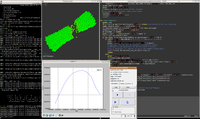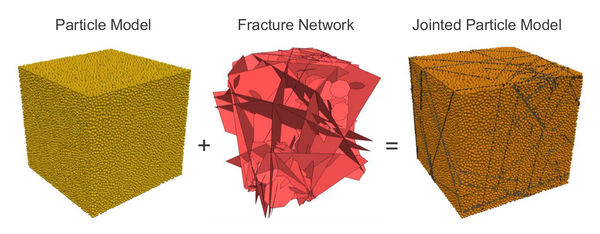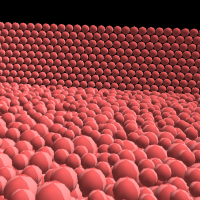Difference between revisions of "Screenshots and videos"
From Yade
m (→Videos: added short explanation to videos.) |
|||
| (46 intermediate revisions by 9 users not shown) | |||
| Line 1: | Line 1: | ||
| − | + | If you are working with yade, please upload some of your screenshots to show others your work! |
|
| + | =Videos= |
||
| + | If you click on one of the following links, you will be redirected to a page that contains the videos: |
||
| + | * [[Outflows | Outflows]] |
||
| + | * [[Ball mill | Ball mill]] |
||
| + | * [[Representing_surfaces_beams_wires | Representing surfaces beams wires]] |
||
| + | * [[Fluid-solid_coupling | Fluid-solid coupling]] |
||
| + | * [[Processing_machines | Processing machines]] |
||
| + | * [[Miscellaneous_videos | Miscellaneous videos]] |
||
=Screenshots= |
=Screenshots= |
||
| Line 9: | Line 17: | ||
{{clr}} |
{{clr}} |
||
| − | ==[[Scr:Simple Spring|Simple Spring]]== |
||
| − | [[Image:scr_sspring_thumb.png|right]] |
||
| − | First implemented model was simple spring. It handles collision between rigid bodies of arbitrary shape (only sphere and box are currently implemented). This very primitive model served as testing ground for yade framework design. |
||
| + | ==Jointed/Fractured Media== |
||
| − | [[Scr:Simple Spring|more >>]] |
||
| + | YADE can be used to model media containing pre-existing fractures/discontinuities. The module was initially developed for the study of fractured rock masses as described in refs [1], [2] and [3]. |
||
| − | {{clr}} |
||
| + | [[Image:DEMDFN.jpg|600px]] |
||
| − | ==[[Scr:Discrete Element Method|Discrete Element Method]]== |
||
| − | [[Image:scr_dem_thumb.png|right]] |
||
| − | A first real-world application of Spherical Discrete Element Method is implemented, with a catchy name Yade OpenDEM. Handles shearing forces between spheres, cohesive forces with modified mohr-coulomb criterion. This is a reimplementation from ground-up of SDEC program, which has been used for over ten years in University of Joseph Fourier in Grenoble, and many PhDs were done with it. |
||
| + | Discrete fracture network (DFN) can be imported as meshed surfaces and embeded into a predefined intact medium consisting of bonded particles. Interactions located across a discontinuity surface are identified and their behavior can be adjusted according to the user's choice (cohesive, frictional,...). An option provides the possibility to orientate the contact geometry in agreement with the discontinuity surface to get rid of the particle shape (for more details, see refs [1], [2] and [3]). An example showing how to use this module is provided in example/jointedCohesiveFrictionalPM/ |
||
| − | [[Scr:Discrete Element Method|more >>]] |
||
| − | {{clr}} |
||
| + | [1] http://dx.doi.org/10.1016/j.jmps.2011.01.009 |
||
| − | ==[[Scr:Finite Element Method|Finite Element Method]]== |
||
| − | [[Image:scr_fem_thumb.png|right]] |
||
| − | First implementation of Finite Element Method. Using tetrahedron element with small deformations. This is a proof-of-concept showing that FEM is possible with yade, and we hope that later yade will be extended with more FEM-based models. |
||
| + | [2] http://dx.doi.org/10.1016/j.ijrmms.2012.02.009 |
||
| − | [[Scr:Finite Element Method|more >>]] |
||
| − | {{clr}} |
||
| − | |||
| − | ==[[Scr:Mass Spring|Mass Spring System]]== |
||
| − | [[Image:scr_mass_spring_thumb.png|right]] |
||
| − | This is a very simple mass spring system, used to model a cloth. Springs with given stiffness are connected at nodes, we have done it as a quick way to show that cloth calculations are also possible with yade, but this model is by no means serious. |
||
| + | [3] http://dx.doi.org/10.1111/j.1365-246X.2012.05642.x |
||
| − | [[Scr:Mass Spring|more >>]] |
||
| − | {{clr}} |
||
| − | |||
| − | ==[[Scr:Lattice Geometrical Model|Lattice Geometrical Model]]== |
||
| − | [[Image:scr_lgm_thumb.png|right]] |
||
| − | This model was written as a PhD work of one of the yade authors. Is aims to model fracture process of concrete, giving useful real-world predictions about fracturing of speciemens under heavy load. |
||
| − | |||
| − | [[Scr:Lattice Geometrical Model|more >>]] |
||
| − | {{clr}} |
||
| − | |||
| − | ==[[Scr:DEM with local moment law|Discrete Element Method with Local Moment Law]]== |
||
| − | [[Image:scr_mdem_thumb.png|right]] |
||
| − | Discrete Element Method has been extended with law of conversion of momentum at the contact point. Resulting in a complete model for simulations of spherical elements. This has opened new broad variety of model applications, including deformable non-rigid body simulations, concrete and steel modelling. And later - after yade will have non linear models implemented - other kinds of plastic, viscoplastic, elastoplastic behaviours using spherical elements. |
||
| − | |||
| − | [[Scr:DEM with local moment law|more >>]] |
||
| − | {{clr}} |
||
| − | |||
| − | ==[[Scr:Tetrahedron|Tetrahedron Discrete Model]]== |
||
| − | [[Image:scr_tetr_thumb.png|right]] |
||
| − | This model is a PhD work of one of yade authors. It is not complete yet, but aims to model rocks with an application for cliff stability, giving useful real-world predictions whether the cliff will fall. |
||
| − | |||
| − | [[Scr:Tetrahedron|more >>]] |
||
{{clr}} |
{{clr}} |
||
==[[Scr:Other|Other]]== |
==[[Scr:Other|Other]]== |
||
[[Image:scr_other_thumb.png|right]] |
[[Image:scr_other_thumb.png|right]] |
||
| − | Yade is now good enough to produce some results. Those results are at first compared with results from other numerical computations software, then with real-world experiments. Several articles are planned to be written about it. For now you can have a short glance at what kind of results we can produce so far. Bear in mind that this is just a quick look at screenshots and nothing more. |
+ | Yade is now (2007) good enough to produce some results. Those results are at first compared with results from other numerical computations software, then with real-world experiments. Several articles are planned to be written about it. For now you can have a short glance at what kind of results we can produce so far. Bear in mind that this is just a quick look at screenshots and nothing more. |
[[Scr:Other|more >>]] |
[[Scr:Other|more >>]] |
||
{{clr}} |
{{clr}} |
||
| − | |||
| − | =Videos= |
||
| − | |||
| − | == Ball Mill - 125 000 spheres == |
||
| − | |||
| − | {{#evp:youtube|DsLd7lY3LAQ}} |
||
| − | |||
| − | A sample of simulation of movement of 125 000 spheres with YADE. |
||
| − | This simulation take 14h30m for 50 000 iterations on laptop with Intel(R) Core(TM)2 Duo CPU T8100 @ 2.10GHz processor and 2GB memory. So, perfomance was 0.95 iter/sec. |
||
| − | |||
| − | See yade script [http://bazaar.launchpad.net/~yade-dev/yade/trunk/annotate/2099/examples/STLImporterTest.py here] (it need this [http://bazaar.launchpad.net/%7Eyade-dev/yade/trunk/download/svn-v4%3A02f7d466-02ed-0310-b97e-c604c3e52537%3Atrunk%3A1353/1353%4002f7d466-02ed-0310-b97e-c604c3e52537%3Atrunk%252Fexamples%252Fbaraban.stl/baraban.stl stl-file] for the mill shape.) |
||
| − | {{clr}} |
||
| − | |||
| − | == Ball Mill == |
||
| − | {{#evp:youtube|KUv26xlh89I}} See [http://bazaar.launchpad.net/~yade-dev/yade/trunk/annotate/1743/examples/mill.py yade script]. The mill shape is constructed parametrically from within the script itself. |
||
| − | {{clr}} |
||
| − | |||
| − | == Surface triangulation and filling == |
||
| − | {{#evp:youtube|PZVruIlUX1A}} Sphere packing (regular) is generated to fit inside the horse-shaped triangulated surface (imported from file). The same horse is the used underneath, on which the spheres fall from above. Script is [http://bazaar.launchpad.net/~yade-dev/yade/trunk/annotate/1744/scripts/test/gts-horse.py here] |
||
| − | {{clr}} |
||
| − | |||
| − | == Representing beams and wires with connected cylinder == |
||
| − | [[File:Cylinder-sphere.png|150px|right]] |
||
| − | [http://www.youtube.com/watch?v=iGHBb3nzOx0 Video] |
||
| − | |||
| − | Connected cylinders with rounded ends (alternatively seen as Minkowski sum of a polyline and a sphere enables the description of interaction between wires or rods and particles, with a smooth interface. The simulation is defined in [http://bazaar.launchpad.net/~yade-dev/yade/trunk/annotate/head%3A/scripts/test/chained-cylinder-roots.py this script]. |
||
| − | |||
| − | == Experimantal feature: live update of plotting == |
||
| − | {{#evp:youtube|Pn0XsdnrLIM}} This video deomonstares a live plot generated during calculation, to make this possible a [http://tkinter.unpythonic.net/wiki/mtTkinter mtTkinter] library had to be used. |
||
| − | {{clr}} |
||
| − | |||
| − | ==Sample Yade Session== |
||
| − | [[Image:sample yade thumb.png|right]] |
||
| − | Short example session of working with yade was recorded, due to filesize constraints it has been cut and is little faster. So to see exactly what happens you will have to use the 'pause' button in your video player. |
||
| − | |||
| − | If you wonder how to toggle axis, and grid - those are commands of qglviewer. It's 'a' and 'g'. |
||
| − | |||
| − | [http://yade.berlios.de/content/06-videos______/sample.avi download 3.9 MB >>] |
||
| − | {{clr}} |
||
| − | |||
| − | ==Second Sample Session, with DEM== |
||
| − | [[Image:sample dem thumb.png|right]] |
||
| − | A sample simulation with DEM was recorded, and displays just how yade looks like, when it is in use. |
||
| − | |||
| − | [http://yade.berlios.de/content/06-videos______/dem.avi download 2.3 MB >>] |
||
| − | {{clr}} |
||
| − | |||
| − | ==Discrete Element Method - 125 000 spheres== |
||
| − | [[Image:dem 125k thumb.png|right]] |
||
| − | As first real-world application of yade Spherical Discrete Element Method is implemented. Handles shearing forces between spheres, cohesive forces with modified mohr-coulomb criterion. |
||
| − | |||
| − | 125 000 spheres were generated in a cubical volume, and fell down in the graivty. The calculation took three days, and is available here in two versions - small and big. |
||
| − | |||
| − | [http://yade.berlios.de/content/06-videos______/125k_sm.avi download 2.2 MB >>] |
||
| − | {{clr}} |
||
| − | |||
| − | ==Lattice Geometrical Model== |
||
| − | [[Image:lattice thumb.png|right]] |
||
| − | This model is a PhD work of one of the yade authors. Is not complete yet, but aims to model fracture process of concrete, giving useful real-world predictions about fracturing of speciemens under heavy load. |
||
| − | |||
| − | On this video a small concrete speciemen is subject to uniaxial extension, and fracture process occurs in the middle. |
||
| − | |||
| − | [http://yade.berlios.de/content/06-videos______/lattice.avi download 1.8 MB >>] |
||
| − | {{clr}} |
||
| − | |||
| − | ==Finite Element Method== |
||
| − | [[Image:FEM thumb.png|right]] |
||
| − | Depending on the parameters of FEMBeam filegenerator, different nodes of the FEM beam can be moved, so here a tension simulation was performed. |
||
| − | |||
| − | [http://yade.berlios.de/content/06-videos______/fem.avi download 2.6 MB >>] |
||
| − | {{clr}} |
||
| − | |||
| − | ==Discrete Element Method based on Tetrahedrons== |
||
| − | [[Image:tetrahedrons thumb.png|right]] |
||
| − | First effects of making a DEM simulation with tetrahedrons. It is still not working correctly and needs more work to be done. |
||
| − | |||
| − | [http://yade.berlios.de/content/06-videos______/tetrahedrons.mpg download 3.3 MB >>] |
||
| − | {{clr}} |
||
| − | |||
| − | ==Tetrahedrons with Interacting Geometry of Four Spheres== |
||
| − | [[Image:tetrahedrons spheres thumb.png|right]] |
||
| − | Another try at implementing tetrahedrons. This is just a simple example that demonstrates how to add new models to yade. Later it will become a part of yade manual, currently the instructions related to this example can be found here. |
||
| − | |||
| − | Also this video demonstrates new yade's capability: interactively moving/rotating objects inside the simulation. |
||
| − | |||
| − | [http://yade.berlios.de/content/06-videos______/tet_as_spheres.mpg download 10.0 MB >>] |
||
| − | {{clr}} |
||
| − | |||
| − | ==Mass Spring System== |
||
| − | [[Image:mass spring thumb.png|right]] |
||
| − | This is a very simple mass spring system, used to model a cloth. Springs with given stiffness are connected at nodes, we have done it as a quick way to show that cloth calculations are also possible with yade, but this model is by no means serious. |
||
| − | |||
| − | Here you can see a video of some simulation performed with it. |
||
| − | |||
| − | [http://yade.berlios.de/content/06-videos______/massspring.avi download 2.5 MB >>] |
||
| − | {{clr}} |
||
| − | |||
| − | ==Simple Spring== |
||
| − | [[Image:rigid body thumb.png|right]] |
||
| − | First implemented model was simple spring. It handles collision between rigid bodies of arbitrary shape (only sphere and box are currently implemented). This very primitive model served as testing ground for yade framework design. |
||
| − | |||
| − | Here you can see a video of some simulation performed with it. Particle segragation due to size can be observed. |
||
| − | |||
| − | [http://yade.berlios.de/content/06-videos______/rigidbody.avi download 2.5 MB >>] |
||
| − | {{clr}} |
||
| − | |||
| − | =Making Videos= |
||
| − | |||
| − | Wondering how those videos were produced? [[New:Making videos|Here's an explanation >>]] |
||
| − | [[Category:Screenshots]] |
||
| − | [[Category:Overview]] |
||
Latest revision as of 14:40, 25 July 2014
If you are working with yade, please upload some of your screenshots to show others your work!
Videos
If you click on one of the following links, you will be redirected to a page that contains the videos:
- Outflows
- Ball mill
- Representing surfaces beams wires
- Fluid-solid coupling
- Processing machines
- Miscellaneous videos
Screenshots
Uniaxial tension/compression test
This example can be found in examples/concrete/uniax.py
Jointed/Fractured Media
YADE can be used to model media containing pre-existing fractures/discontinuities. The module was initially developed for the study of fractured rock masses as described in refs [1], [2] and [3].
Discrete fracture network (DFN) can be imported as meshed surfaces and embeded into a predefined intact medium consisting of bonded particles. Interactions located across a discontinuity surface are identified and their behavior can be adjusted according to the user's choice (cohesive, frictional,...). An option provides the possibility to orientate the contact geometry in agreement with the discontinuity surface to get rid of the particle shape (for more details, see refs [1], [2] and [3]). An example showing how to use this module is provided in example/jointedCohesiveFrictionalPM/
[1] http://dx.doi.org/10.1016/j.jmps.2011.01.009
[2] http://dx.doi.org/10.1016/j.ijrmms.2012.02.009
[3] http://dx.doi.org/10.1111/j.1365-246X.2012.05642.x
Other
Yade is now (2007) good enough to produce some results. Those results are at first compared with results from other numerical computations software, then with real-world experiments. Several articles are planned to be written about it. For now you can have a short glance at what kind of results we can produce so far. Bear in mind that this is just a quick look at screenshots and nothing more.


